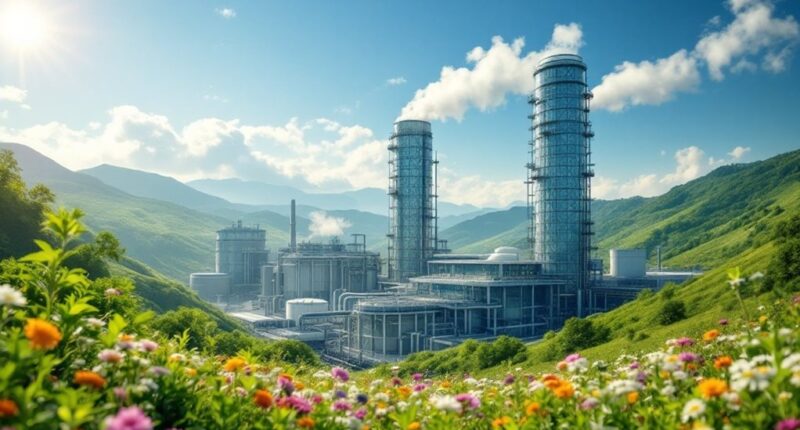Carbon capture and utilization systems are like superheroes for the environment, tackling greenhouse gas emissions head-on. With methods like post-combustion capture that snags CO2 after burning fossil fuels, and Direct Air Capture, which sweeps CO2 straight from the atmosphere, these technologies are essential for hitting net-zero targets. Sure, they face challenges like high costs—think of it as a pricey gym membership—but their potential makes them worth the investment. Curious? There’s more to explore about how these innovations can save the planet!

In the quest for a net-zero future, carbon capture technologies are frequently touted as the superheroes of environmental protection—minus the capes, of course. These innovative systems aim to tackle the colossal challenge of greenhouse gas emissions, primarily carbon dioxide (CO2), which are mainly generated from burning fossil fuels. Among the most widely recognized methods is post-combustion carbon capture, a technique that captures CO2 after it has done its job of powering our homes and industries. By utilizing liquid solvents, this method can snatch up to 90% of CO2 emissions, making it a popular retrofit option for existing power plants.
On the other end of the spectrum lies pre-combustion carbon capture, which involves gasifying fuel to create syngas—a fancy term for a mixture that includes hydrogen. This process captures CO2 before combustion occurs, offering better efficiency, but it’s primarily suited for new power plants. Then there’s oxy-fuel combustion, which burns fuel in pure oxygen, producing a concentrated stream of CO2 that’s a breeze to capture. Picture it as a CO2 factory, minus the assembly line workers.
Pre-combustion carbon capture and oxy-fuel combustion: two innovative strategies transforming CO2 emissions into manageable resources.
For those looking for something a tad more adventurous, direct air capture (DAC) extracts CO2 straight from the atmosphere. The Orca facility in Iceland showcases this technology by capturing an impressive 4,000 tons of CO2 annually. However, it requires a hefty energy input, so don’t expect it to be the magic solution just yet. Additionally, DAC technology holds potential for scaling, making it a promising solution for historic CO₂ emissions. This is crucial as carbon emissions have surged to 39 billion tons annually, highlighting the urgent need for effective solutions.
Meanwhile, enhanced weathering accelerates nature’s process of CO2 absorption by spreading crushed rocks, a technique that also boosts soil fertility. Finally, bioenergy with carbon capture and storage (BECCS) combines biomass energy with CO2 removal, though concerns over land use and food crop competition linger.
In the grand scheme of carbon capture, these technologies represent diverse strategies to combat climate change, promising a cleaner, greener future—if only they can work together like an elite superhero team.
Frequently Asked Questions
How Do Carbon Capture Systems Impact Local Ecosystems?
Carbon capture systems can substantially impact local ecosystems, much like an uninvited guest at a party. They require vast land for facilities and pipelines, potentially disrupting habitats.
Risks of CO2 leakage could contaminate groundwater, while seismic activity might be triggered by underground storage. Additionally, the capture process demands large volumes of water, straining local resources.
These ecological uncertainties raise questions about long-term effects, making it vital to monitor changes closely and carefully.
What Are the Costs Associated With Implementing Carbon Capture Technologies?
Implementing carbon capture technologies can be a financial rollercoaster, with costs ranging from $15 to a jaw-dropping $1,000 per metric ton of CO2 captured. Factors like the CO2 concentration in emissions and the type of technology used play significant roles.
While initial investments can feel like buying a ticket to a theme park, the potential for cost reductions through innovation and economies of scale offers a glimmer of hope for a more sustainable future.
How Long Can Captured Carbon Be Stored Safely?
Captured carbon can be stored safely for millions of years in suitable geological formations, much like stashing away last year’s holiday decorations in a sturdy attic. Well-managed sites boast over 99% retention for more than a millennium, thanks to clever mechanisms such as structural and mineral trapping.
Monitoring guarantees these carbon stashes stay put, while rigorous site selection and regulations act as the bouncers, keeping potential risks at bay. It’s like a long-term investment for our planet.
Are There Any Health Risks Related to Carbon Capture Technologies?
Health risks associated with carbon capture technologies can be quite alarming. High concentrations of CO2 can lead to unconsciousness within a minute, causing serious respiratory issues. Imagine trying to breathe in a room full of whipped cream—tricky, right?
Not to mention, these systems don’t capture harmful pollutants like NOx or mercury, which can worsen asthma. Communities near these facilities may face higher health risks, sparking significant concerns about environmental justice. It’s a delicate balance
What Role Do Government Policies Play in Carbon Capture Advancements?
Government policies play a pivotal role in advancing technologies by providing funding, creating regulatory frameworks, and fostering public-private partnerships. Think of it like a coach guiding a team: they set the strategy, allocate resources, and encourage collaboration.
For instance, tax credits and grants entice companies to innovate, while clear regulations lay the groundwork for sustainable practices. Without such support, carbon capture advancements might resemble a soccer game without a referee—chaotic and lacking direction.









